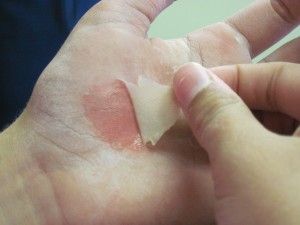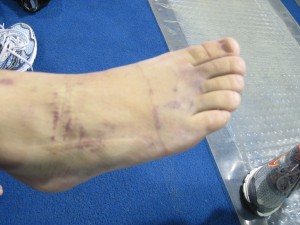Like any coach I HATE to see any gymnast get hurt.
Unfortunately Injuries are a reality in any sport and it is not a matter of IF a gymnast is going to get hurt, it is a matter of WHEN. Knowing that every gymnast is going to experience some kind of injury that will prevent her from optimal performance in practice or competition should encourage us (as gymnastics professionals) to have a plan. I have told the athletes I work with, There are only 2 guarantees in gymnastics:
- You are going to get hurt
- You are going to get frustrated
 Injuries can range from as small as a rip to the obvious fractures and torn ligaments and ruptured tendons. Each athlete will deal with their injury differently. Some have a very high tolerance for pain while others have a relatively low threshold. I have had gymnasts who when they ripped you would have thought that someone had taken a blow torch to their hand and other gymnasts who continued to work out on what we discovered was a broken bone in her ankle.
Injuries can range from as small as a rip to the obvious fractures and torn ligaments and ruptured tendons. Each athlete will deal with their injury differently. Some have a very high tolerance for pain while others have a relatively low threshold. I have had gymnasts who when they ripped you would have thought that someone had taken a blow torch to their hand and other gymnasts who continued to work out on what we discovered was a broken bone in her ankle.
HOW ARE YOU GOING TO REACT TO AN INJURY?
A coaches attitude towards an injury is so important. You want the gymnast to be able to tell you if something hurts BUT they should also tell you how much they think they can do.
“My ankle really hurts, I think I am only going to be able to do Vault OR Floor. Which should I do?”
If a coach over reacts to an injury then the gymnast will as well. I have seen coaches under reacts to an injury, the gymnast may learn NOT to tell the coach when they are hurt or feel that the coach doesn’t care. It certainly is a fine line.
RETURNING TO THE GYM
Following an injury we all want the gymnasts to return to practice and be part of the group. It is good for their psychological state, it keeps the desire to return high. We can all think of an athlete who did not return from a relatively minor injury because of too much time off and they felt that the group moved on with out them.
I like to see the girls back at their normal practice schedule even if hours are reduced. Speaking to an athlete on their return is a crucial part of their rehab. What is the plan? Because of the nature of women’s gymnastics leg injuries are the most prevalent as well as the most limiting in the gym. If an athlete hurts her leg, This is an opportunity for them to really make improvements on bars. They can learn to be more subtle with their arm movements on dance. I have had a great deal of success with gymnasts practicing “mental choreography” for leg events that they can not do (I will write more in this later).
If she has injured her arm, there really is a lot they can do in the gym. Tramp will become their new best friend! There are literally thousands of drills and skills that kids can do on tramp for every event. (Who knows maybe that will be the topic of another dvd!)
It is important that the gymnasts know that EVERYTHING WILL BE OK. This is a set back, but it is also a time to let other things heal. This is also an opportunity to make improvements in other areas.
- Strength
- Flexibility
- Dance
- Rhythm
- Speed
Your relationship with the medical community is another aspect often overlooked. Face it, there are some out there who HATE gymnastics.They think gymnastics is a form of abuse. My daughter had a Dr who was a hater. Can you imagine the arguments we had? We are talking serious fireworks in the office. Needless to say- he is no longer her Dr. I will save my tirade against those closed mined individuals for another time. Find a set of DRs who understand sports and children. The fact that gymnastics is a big part of their life and that taking it away can be crushing. Invite them in to your gym. (give their kid a free trial class!). Show them what you do and that you really care about the children. If they know you and your concern for safety and the individual recovery they are more likely to let a gymnast return to limited gymnastics sooner. I actually had a DR put a kid in a cast for a fairly minor sprain because he knew this particular athlete WOULD NOT stay off it. This was a great thing and the DR called me up and told me why.
Find a great Physical Therapist in the area. Invite them in.
Every time an athlete goes to see a DR or a PT they are usually given exercises for their particular injury. Start a big 3 ring binder and divide into body parts. Make a copy of the exercises and keep them in the book.
Have some pre-designed work outs for athletes with limitation. Sort of a “Help my ankle hurts Vault work out” Or Bars, Beam, Floor. This will save you a lot of time and aggravation as you work with your healthy athletes.
Proper nutrition is a key component to injury recovery. Here are 2 good articles.
Nutrition as a key player in injury recovery
Exercise Injuries, A diet for recovery





